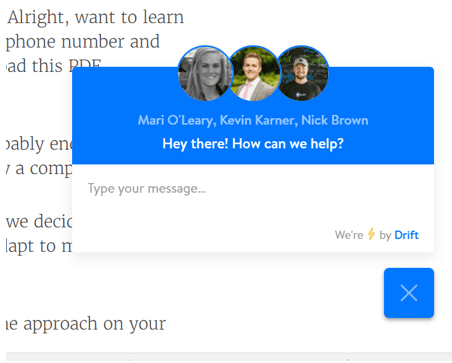11 TIPS FOR CONVERTING QUALITY INBOUND LEADS FROM YOUR BLOG

The modern marketer knows about inbound marketing. You already know an inbound marketing strategy includes a blog, but not just any blog. Your company’s blog must include new and engaging content posted according to schedule, as well as SEO best practices to improve viewership. What you may be wondering as your traffic improves is what to do next in the process. How do you take the traffic your blog generates and convert it into quality inbound leads who want to become customers?
In this post, we discuss how your blog can be the gateway to improving your visitor-to-lead conversion rates.
1. Critique Your Content
A great company blog goes beyond simply updating followers on company news and events. It focuses on educating its audience, and providing valuable information to its readers. Its posts become tried and true resources, delivering fresh content, on time, every single week. It engages, makes the reader think, and is not a sales pitch. Said differently, a great company blog serves its reader, not itself.
Understanding the concept above is the first step in converting more visitors into leads. Before moving on, think about your own blog, and ask yourself these questions:
- What topics do my readers care about most?
- Are there any new trends that we can write about?
- How is my content helpful to my readers?
- How can my content better serve my readers?
- Am I writing simply for SEO purposes, or to be a trusted resource?
- What sets my content apart from others in my industry?
Set goals for the type of content you want to create, and then work to build your content schedule around those goals. Like fitness, you should take baby steps toward building a strong foundation for your content strategy starting with 1 – 3 topics; then, work up to blogging more frequently on an assortment of useful topics.
2.Improve Your Subscriber List
Subscribers see your posts first. They are more likely to share your posts on social media and interact with you in forums and in the comments of your blog. They provide you with nearly instant traffic to your website, because they are notified as soon as a new post is published. Grow this list. Some tips for growing it include:
- Email marketing – craft a catchy email to encourage contacts to subscribe to your blog. Make it easy by creating a landing page specifically for blog subscriptions.
- A “Hello” bar – Hello bars sit at the top of your blog. They include a quick form field for readers to easily subscribe. It goes away once the person has given their email address.
- Offering something in return – Give your readers something to talk about. If they subscribe, promise a “Subscriber Only” blog post, sent directly after subscribing. If you’re feeling particularly generous, offer an ebook or worksheet that would be useful to your reader in exchange for their email.
- Including social sharing icons – The best way to generate subscribers is to share your content to a larger audience. By making it easy for your readers to share your content with social sharing icons, you will be that much closer to your subscriber goal.
3. Give Conversational Marketing a Go
While conversational marketing could be an ebook on its own, here is a quick and dirty run down of why it is great for your blog. Conversational marketing is essentially a live chat and/or question submission tool that allows your blog readers to interact with you now instead of filling out a form. It’s great for the following reason:
- Anytime someone asks a question, they become a subscriber.
- Some will request information about your company specifically, making them a lead.
- The company Drift saw an increase in leads by 15% by implementing this feature. You can too!
- Having the reader take charge allows you to personalize the experience even further and obtain more topics to blog about.
Here’s what it looks like:

4. Include Calls-to-Action on Every Single Post
What’s worse than a sales pitch blog post? A post that doesn’t encourage the reader to convert into a lead. Think about it – when you read an extremely informative post, you might think “Oh, this is great! How do I learn more about this topic?” When you can’t find more information, you may head over to Google, do another search, and land on someone else’s blog who has opportunities to learn more.
Don’t let the above situation happen to your readers. Offer them additional, gated content on your blog posts. Show that they can learn more through calls-to-actions (CTA) on every post. If you’re worried about making the CTA look appealing, check out HubSpot’s tool. You can create and place the CTA right within your blog without a developer or designer needed. #NoDeveloperNeeded
5. Nurture New Contacts Immediately
Nurtured contacts are qualified leads. Send an email immediately after conversion to stay front of mind and provide even more valuable information to your reader. Nurtured contacts are more likely to visit your blog in the future, have more conversions overall, and become customers quicker during the sales process.
6. Optimize Your Posts – But Don’t Overdo It
Remember: quality content is more beneficial than optimized content. This does not mean that you shouldn’t optimize for search engines though. In fact, by doing a bit of research as to what your readers are looking for, and choosing low competition keywords to write about, you are far more likely to attract qualified traffic to your blog. Qualified traffic is more likely to convert into leads, and thus into customers. A few tips to keep in mind are:
- Include a long-tail keyword in your title
- Link text back to relevant posts ( 2 – 3 times in the post)
- Include relevant images with optimized alt-text
- Don’t stress about the nitty gritty. Great content will be seen.
7. Test, Analyze, Tweak, Repeat
The most important aspect of collecting leads from your blog is learning from past data. Here are some metrics to consider:
- Total views per post
- Total views per topic
- Visit-to-leads per post
- Visit-to-leads per topic
- Month-over-month subscriber growth
- Month-over-month lead growth (from blog)
- Quarterly subscriber growth
- Quarterly lead growth (from blog)
- Year-over-year comparisons
In other words, you’re searching to see what content worked and what didn’t so that you can replicate or eliminate your findings. Test new ideas and monitor their performance as well. There is no one-size-fits-all approach for blogging. You must find your own stride.
After reading our list, what do you think is working and not working on your own blog? Let us know in the comments!
